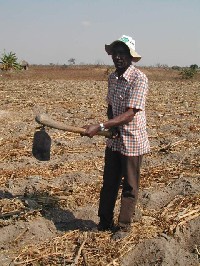Labour-saving technologies and practices: improved use of hoes for land preparation, planting and weeding
The following contains a guideline on how to better use hoes, and how to improve them. Advantages are highlighted which include labour saving, livelihood resilience strengthening, equipment, skills, cost and infrastructure. Disadvantages are labour, livelihood, equipment and risk.
Description
In many countries in Africa, 90 percent of primary cultivation is carried out using digging hoes. Traditional digging hoes are usually heavy (1.2 kg to 2.2 kg) with short handles and are commonly used for all primary and secondary cultivation operations. There are many work rates for hoes on traditional full tillage systems (indicative only, due to the variability of hoes, local conditions and crops). For land preparation, this is 300 hours per ha per person. Planting requires 80 hours per ha per person. Finally, weeding necessitates 140 hours per ha per person, down to 65 hours per ha per person for third weeding. Worn down digging hoes with short handles, are commonly used as weeding or planting hoes or by women and children for primary and secondary cultivation.
1. Improved hoes
- Properly maintained hoes with correctly sharpened blades facilitate cultivation to the appropriate depth and make the task easier.
- They require files for sharpening blades. Improved hoes specifically designed for weeding, such as long-handled light hoes (0.7 kg to 1.1 kg), push/pull hoes, tined hoes, or wheeled hoes can enable substantial savings in time and energy to be achieved.
- Work rates with weeding hoes are greatly increased when crops are planted in rows so that weeding can be carried out in uniform inter-row lanes.
- Row planting is essential for the use of push or pull hoes and wheeled hoes.
2. Advantages
2.1 Labour saving
Tasks are made easier by using well-maintained tools with appropriate length handles. Specially designed weeding hoes, such as long-handled light hoes, push/pull hoes, tined hoes, or wheeled hoes, used with row cropping, reduce work times by at least half.
2.2 Livelihood resilience strengthening
Improved hoes are suitable for small plot sizes, require low investment and are easy to adopt. They help to improve production and save drudgery and time.
2.3 Equipment
Tools are relatively easy to fabricate, maintain and repair.
2.4 Skills
No additional skills are required but may require a change of attitude towards different working postures. Emphasis needs to be placed on the improved working rate and promoting acceptability.
2.5 Cost
It requires low investment and operating costs and hence minimal financial risks.
2.6 Infrastructure
Minimal additional demands on the system.
3. Disadvantages
3.1 Labour
The reduction in labour with improved hoes is still very low compared to draught animal or motorized power. There are overall low work rates per labourer and high levels of drudgery.
3.2 Livelihood
Poor quality of primary tillage work and poor timeliness.
3.3 Equipment
Push/pull hoes and wheeled hoes can normally only be used with emergent weeds and not established weeds.
3.4 Risk
There are a number of cultural and gender aspects associated with the use of hoes and local attitudes relating to these will need to be assessed and addressed. For example, the upright working position used with correctly designed weeding hoes is considered by some to suggest that the person is not working hard.
Figure 1. Man hoeing

©FAO/TECA
4. Related/associated technologies
- Conservation agriculture for smallholder farmers in dryland areas: ID 4676.
- Labour-saving technologies: improved hand tools: ID 7295.
- Labour-saving technologies and practices: conservation agriculture: ID 7294
- Labour-saving technologies: integrated pest management: ID 7298.
- Labour-saving technologies: raised beds: ID 7299.
- Labour-saving technologies and practices: renewable energy resources: ID 7300.
- Labour-saving technologies and practices: row planting, hand seeders and planters: ID 7301.
- Labour-saving technologies and practices: seeds and crops: ID 7302.
- Labour-saving technologies and practices: weed wipes and knapsack sprayers: ID 7303.
5. Objectives fulfilled by the project
5.1 Labour-saving technology (LST)
The technology facilitates labour tasks and reduces work time. The hoes are also very easy to use.
5.2 Pro-poor technology
The technology requires low investment and is easy to adopt.
